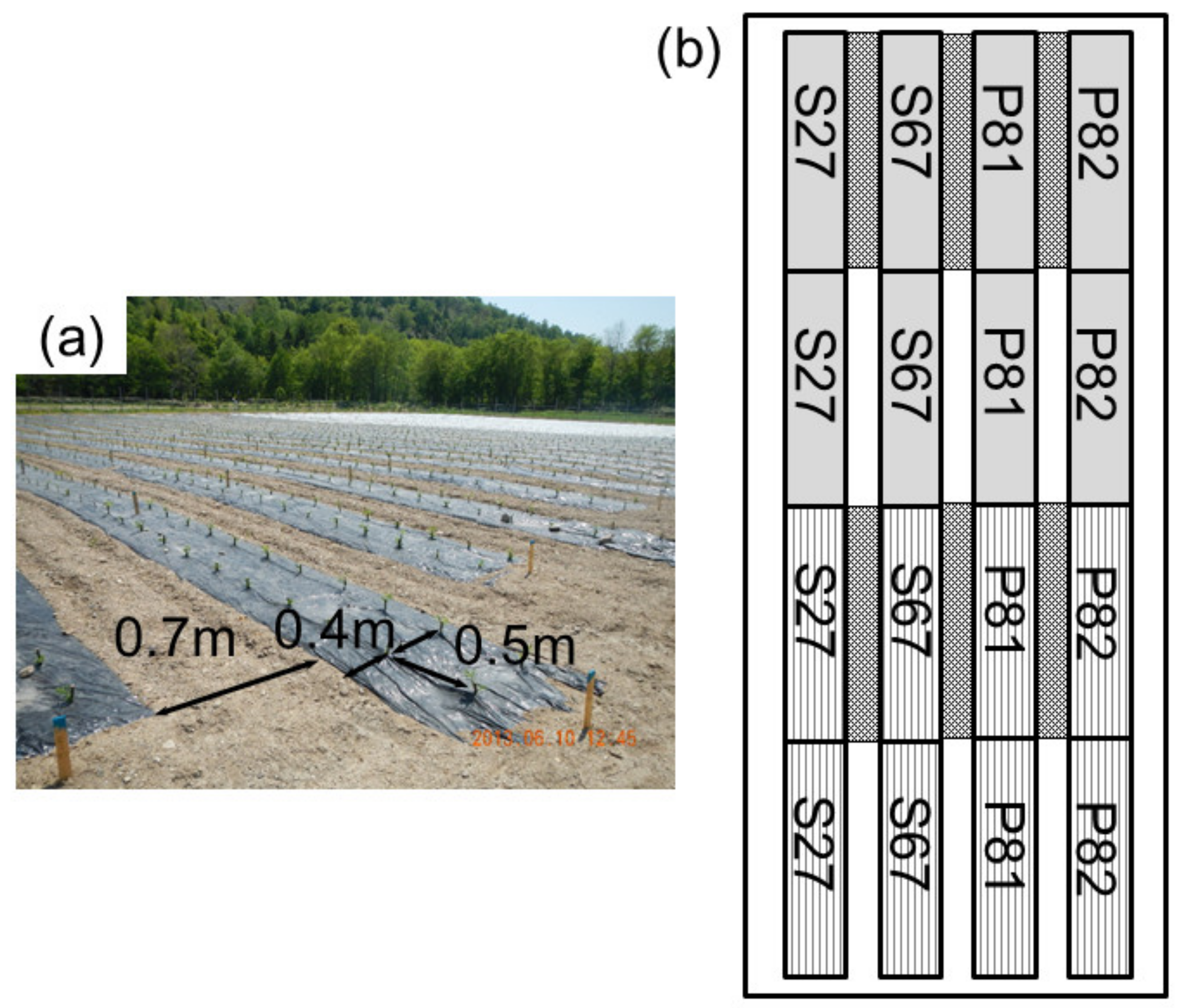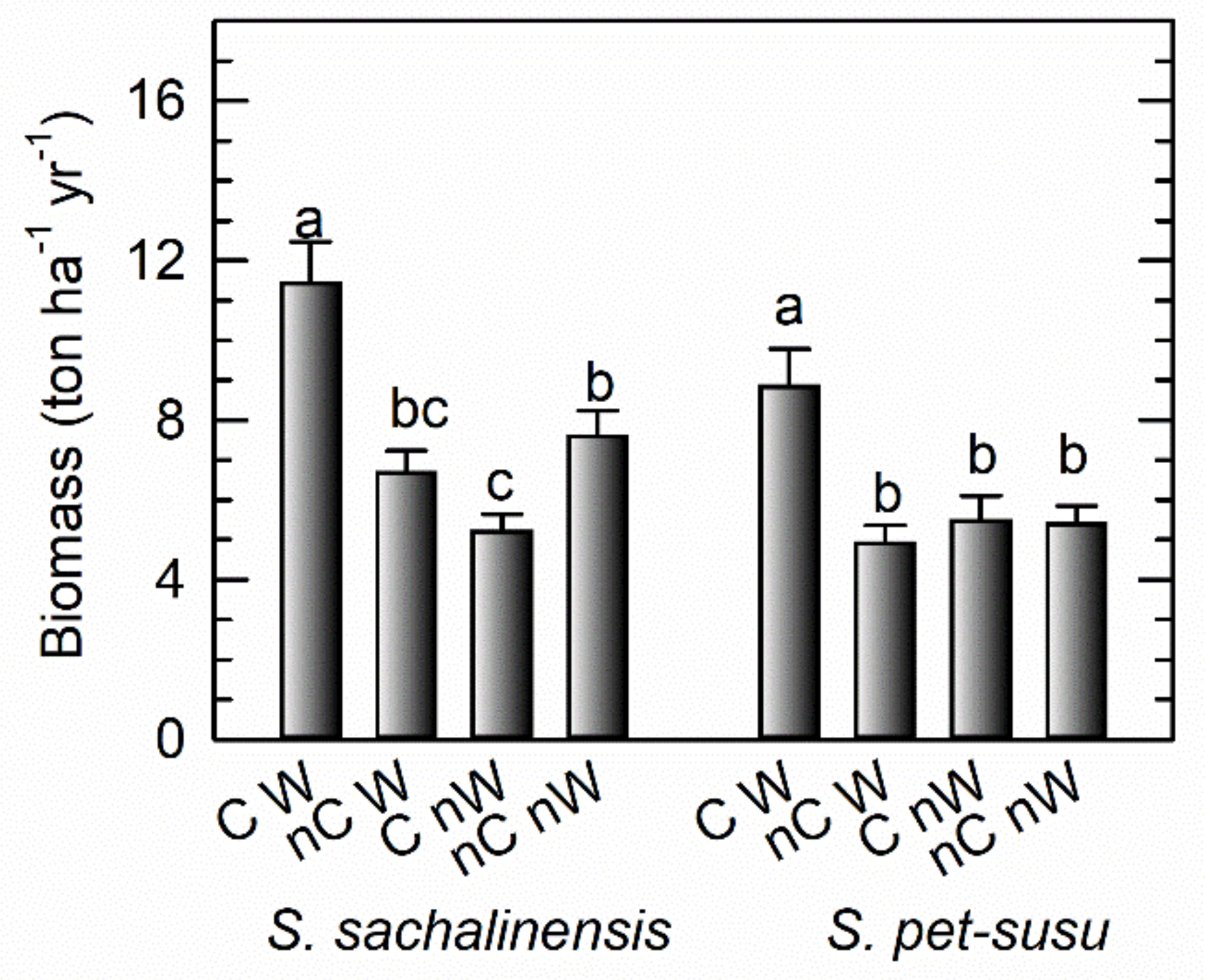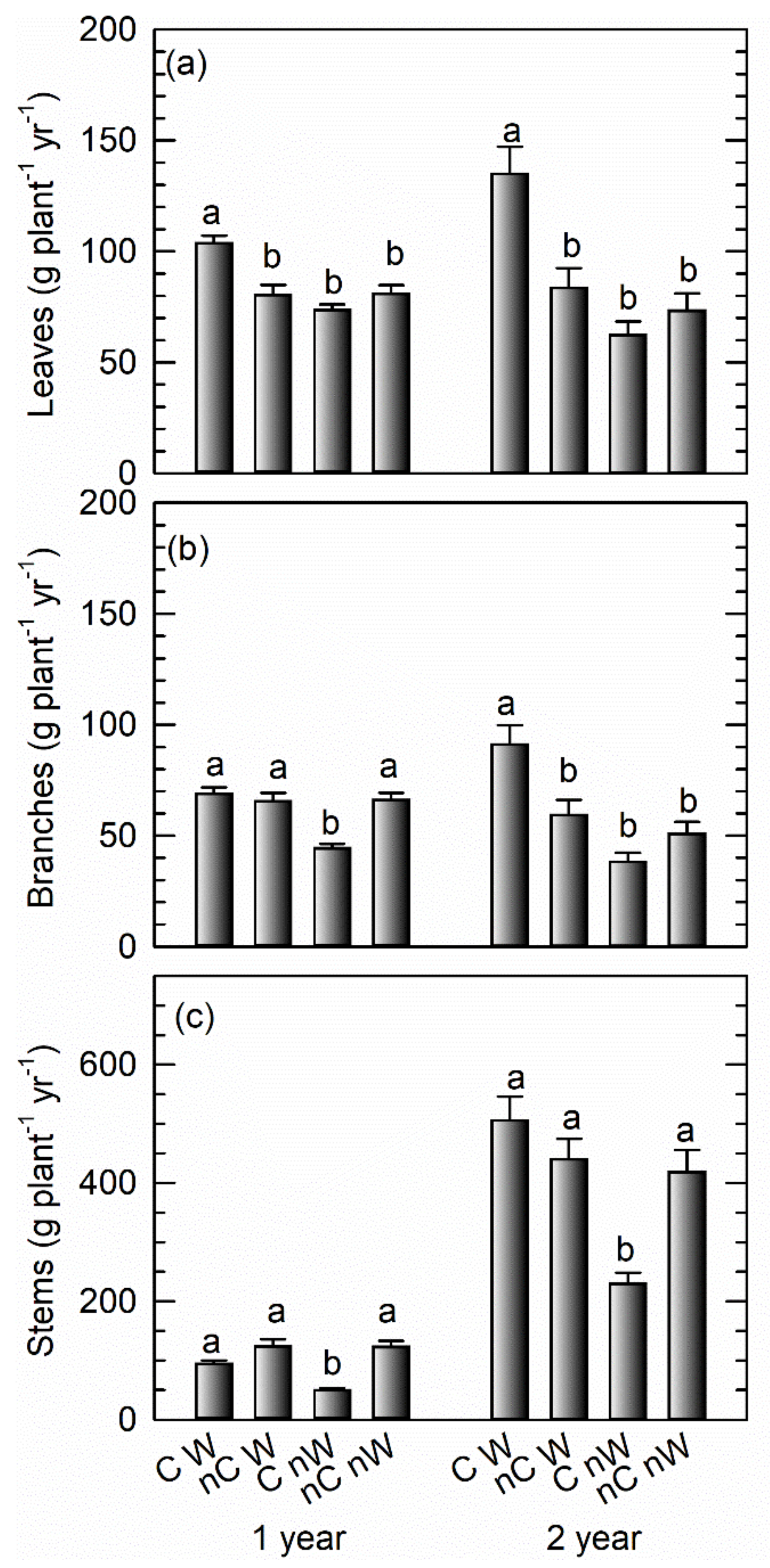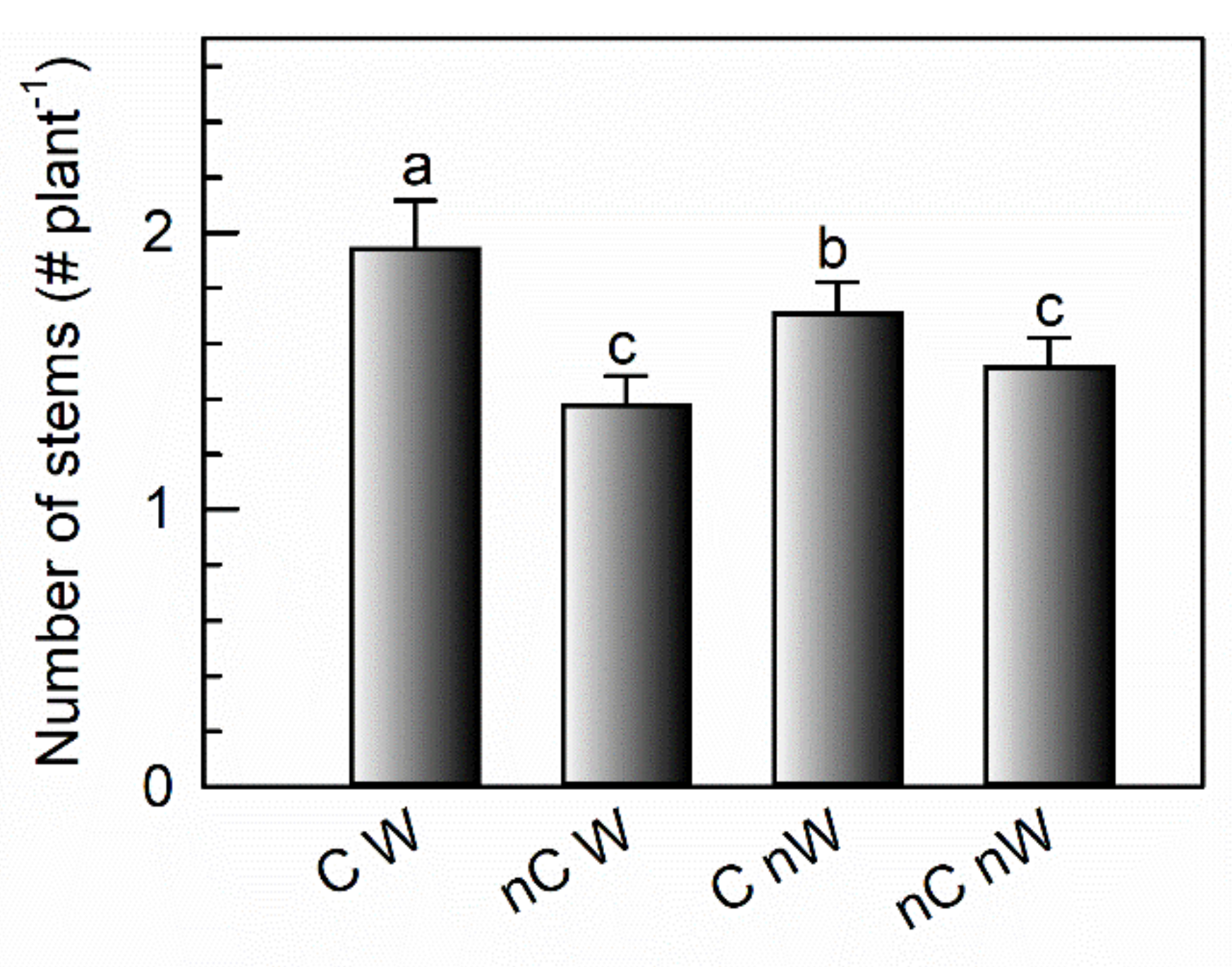High Biomass Productivity of Short-Rotation Willow Plantation in Boreal Hokkaido Achieved by Mulching and Cutback
Abstract
:1. Introduction
2. Materials and Methods
2.1. Study Site and Experimental Design
2.2. Allometric Equations
2.3. Growth Measurements and Harvesting
2.4. Nitrogen Analysis
2.5. Statistical Analyses
3. Results
4. Discussion
4.1. Weed Control by Agricultural Mulch Film
4.2. Cutback
5. Conclusions
Supplementary Materials
Author Contributions
Acknowledgments
Conflicts of Interest
References
- Volk, T.A.; Verwijst, T.; Tharakan, P.J.; Abrahamson, L.P.; White, E.H. Growing fuel: A sustainability assessment of willow biomass crops. Front. Ecol. Environ. 2004, 2, 411–418. [Google Scholar] [CrossRef]
- Dimitriou, I.; Rosenqvist, H.; Berndes, G. Slow expansion and low yields of willow short rotation coppice in Sweden; implications for future strategies. Biomass Bioenerg. 2011, 35, 4613–4618. [Google Scholar] [CrossRef]
- Manual for SRC Willow Growers; Lantmännen Agroenergi: Stockholm, Sweden, 2012; Available online: http://www.voederbomen.nl/wordpress/wp-content/uploads/2012/08/ManualSRCWillowGrowers.pdf (accessed on 22 March 2020).
- Abrahamson, L.P.; Volk, T.A.; Smart, L.B.; Cameron, K.D. Shrub Willow Biomass Producser’s Handbook; State University of New York College of Environmental Science and Forestry (SUNY-ESF): Syracuse, NY, USA, 2010; Available online: https://www.esf.edu/willow/documents/ProducersHandbook.pdf (accessed on 22 March 2020).
- Snowdon, K.; Mclvor, I.; Nicholas, I. Energy Farming with Willow in New Zealand; IEA Bioenergy Tasks: Paris, France, 2010. [Google Scholar]
- Caslin, B.; Finnan, J.; Johnston, C.; McCracken, A.; Walsh, L. Short Rotation Coppice Willow Best Practice Guidelines. 2010. Available online: https://www.ifa.ie/wp-content/uploads/2013/10/Willow-Best-Practic-Guide-Teagasc-2010.pdf (accessed on 22 March 2020).
- Edelfeldt, S.; Lundkvist, A.; Forkman, J.; Verwijst, T. Establishment and early growth of willow at different levels of weed competition and nitrogen fertilization. Bioenerg. Res. 2016, 9, 763–772. [Google Scholar] [CrossRef]
- Albertsson, J.; Verwijst, T.; Hansson, D.; Bertholdsson, N.O.; Åhman, I. Effects of competition between short-rotation willow and weeds on performance of different clones and associated weed flora during the first harvest cycle. Biomass Bioenerg. 2014, 70, 364–372. [Google Scholar] [CrossRef]
- Kasirajan, S.; Ngouajio, M. Polyethylene and biodegradable mulches for agricultural applications: A review. Agron. Sustain. Dev. 2012, 32, 501–529. [Google Scholar] [CrossRef]
- Brodhagen, M.; Peyron, M.; Miles, C.; Inglis, D.A. Biodegradable plastic agricultural mulches and key features of microbial degradation. Appl. Microbiol. Biotechnol. 2015, 99, 1039–1056. [Google Scholar] [CrossRef]
- Greer, L.; Dole, J.M. Aluminum foil, aluminium-painted, plastic, and degradable mulches increase yields and decrease insect-vectored viral diseases of vegetables. Horttechnology 2003, 13, 276–284. [Google Scholar] [CrossRef] [Green Version]
- Shimazaki, M.; Nesumi, H. A Method for High-Quality Citrus Production Using Drip Fertigation and Plastic Sheet Mulching. Jarq-Jpn. Agric. Res. Q. 2016, 50, 301–306. [Google Scholar] [CrossRef] [Green Version]
- Haapala, T.; Palonen, P.; Korpela, A.; Ahokas, J. Feasibility of paper mulches in crop production: A review. Agric. Food Sci. 2014, 23, 60–79. [Google Scholar] [CrossRef] [Green Version]
- Tarara, J.M. Microclimate modification with plastic mulch. HortScience 2000, 35, 169–180. [Google Scholar] [CrossRef] [Green Version]
- Adhikari, R.; Bristow, K.L.; Casey, P.S.; Freischmidt, G.; Hornbuckle, J.W.; Adhikari, B. Preformed and sprayable polymeric mulch film to improve agricultural water use efficiency. Agric. Water Manag. 2016, 169, 1–13. [Google Scholar] [CrossRef]
- Riege, D.A.; Sigurgeirsson, A. Facilitation of afforestation by Lupinus nootkatensis and by black plastic mulch in south-west Iceland. Scand. J. For. Res. 2009, 24, 384–393. [Google Scholar] [CrossRef]
- Labrecque, M.; Teodorescu, T.I.; Babeux, P.; Cogliastro, A.; Daigle, S. Impact of herbaceous competition and drainage conditions on the early productivity of willows under short-rotation intensive culture. Can. J. For. Res. 1994, 24, 493–501. [Google Scholar] [CrossRef]
- Heiska, S.; Tikkanen, O.P.; Rousi, M.; Julkunen-Tiitto, R. Bark salicylates and condensed tannins reduce vole browsing amongst cultivated dark-leaved willows (Salix myrsinifolia). Chemoecology 2007, 17, 245–253. [Google Scholar] [CrossRef]
- Guidi, W.; Pitre, F.E.; Labrecque, M. Short-rotation coppice of willows for the production of biomass in Eastern Canada. In Biomass—Now Sustainable Growth and Use; Matovic, M.D., Ed.; IntechOpen: London, UK, 2013. [Google Scholar] [CrossRef]
- Zamora, D.S.; Apostol, K.G.; Wyatt, G.J. Biomass production and potential ethanol yields of shrub willow hybrids and native willow accessions after a single 3-year harvest cycle on marginal lands in central Minnesota, USA. Agrofor. Syst. 2014, 88, 593–606. [Google Scholar] [CrossRef]
- Verwijst, T.; Lundkvist, A.; Edelfeldt, S.; Albertsson, J. Development of Sustainable Willow Short Rotation Forestry in Northern Europe; IntechOpen: London, UK, 2013; p. 44392. [Google Scholar]
- Rytter, R.-M. Biomass production and allocation, including fine-root turnover, and annual N uptake in lysimeter-grown basket willows. For. Ecol. Manag. 2001, 140, 177–192. [Google Scholar] [CrossRef]
- Weih, M. Evidence for increased sensitivity to nutrient and water stress in a fast-growing hybrid willow compared with a natural willow clone. Tree Physiol. 2001, 21, 1141–1148. [Google Scholar] [CrossRef]
- Weih, M.; Bonosi, L.; Ghelardini, L.; Ronnberg-Wastljung, A.C. Optimizing nitrogen economy under drought: Increased leaf nitrogen is an acclimation to water stress in willow (Salix spp.). Ann. Bot. 2011, 108, 1347–1353. [Google Scholar] [CrossRef] [Green Version]
- Brereton, N.J.B.; Pitre, F.E.; Shield, I.; Hanley, S.J.; Ray, M.J.; Murphy, R.J.; Karp, A. Insights into nitrogen allocation and recycling from nitrogen elemental analysis and 15N isotope labelling in 14 genotypes of willow. Tree Physiol. 2014, 34, 1252–1262. [Google Scholar] [CrossRef] [Green Version]
- Vigl, F.; Rewald, B. Size matters?—The diverging influence of cutting length on growth and allometry of two Salicaceae clones. Biomass Bioenerg. 2014, 60, 130–136. [Google Scholar] [CrossRef]
- Han, Q.; Harayama, H.; Uemura, A.; Ito, E.; Utsugi, H. The effect of the planting depth of cuttings on biomass of short rotation willow. J. For. Res. 2017, 22, 131–134. [Google Scholar] [CrossRef]
- Utsugi, H.; Uemura, A.; Ishihara, M.; Takahashi, Y.; Ohara, M.; Hashida, K.; Makino, R.; Nojiri, M.; Magara, K.; Ikeda, T.; et al. Biomass Utilization from a Field of Willow; FFPRI: Sapporo, Japan, 2011; Available online: http://www.ffpri.affrc.go.jp/hkd/research/documents/h23biomass.pdf. (In Japanese)
- Maruyama, Y.; Mori, S.; Kitao, M.; Tobita, H.; Koike, T. Effects of fertilization on photosynthetic traits and yield of two willow species. Jpn. J. For. Environ. 2002, 44, 71–75. (In Japanese) [Google Scholar]
- Niiyama, K. The role of seed dispersal and seedling traits in colonization and coexistence of Salix species in a seasonally flooded habitat. Ecol. Res. 1990, 5, 317–331. [Google Scholar] [CrossRef]
- Ito, E.; Uemura, A.; Harayama, H.; Han, Q.; Utsugi, H. Root system development and partitioning of nitrogen in short-rotation willow. Boreal For. Res. 2015, 63, 47–50. (In Japanese) [Google Scholar]
- Rossi, P. Length of cuttings in establishment and production of short-rotation plantations of Salix ‘Aquatica’. New For. 1999, 18, 161–177. [Google Scholar] [CrossRef]
- Verwijst, T.; Lundkvist, A.; Edelfeldt, S.; Forkman, J.; Nordh, N.-E. Effects of clone and cutting traits on shoot emergence and early growth of willow. Biomass Bioenerg. 2012, 37, 257–264. [Google Scholar] [CrossRef]
- Chiba, Y. Plant form analysis based on the pipe model theory. II. Quantitative analysis of ramification in morphology. Ecol. Res. 1990, 6, 21–28. [Google Scholar] [CrossRef]
- Weih, M.; Nordh, N.-E. Characterising willows for biomass and phytoremediation: Growth, nitrogen and water use of 14 willow clones under different irrigation and fertilisation regimes. Biomass Bioenerg. 2002, 23, 397–413. [Google Scholar] [CrossRef]
- Tharakan, P.J.; Volk, T.A.; Nowak, C.A.; Ofezu, G.J. Assessment of canopy structure, light interception, and light-use efficiency of first year regrowth of shrub willow (Salix sp.). Bioenerg. Res. 2008, 1, 229–238. [Google Scholar] [CrossRef]
- Weih, M.; Rönnberg-Wästjung, A.-C. Shoot biomass growth is related to the vertical leaf nitrogen gradient in Salix canopies. Tree Physiol. 2007, 27, 1551–1559. [Google Scholar] [CrossRef] [PubMed]
- Hanley, S.J.; Karp, A. Genetic strategies for dissecting complex traits in biomass willows (Salix spp.). Tree Physiol. 2014, 34, 1167–1180. [Google Scholar] [CrossRef] [PubMed] [Green Version]
- Aylott, M.J.; Casella, E.; Tubby, I.; Street, N.R.; Smith, P.; Taylor, G. Yield and spatial supply of bioenergy poplar and willow short-rotation coppice in the UK. New Phytol. 2008, 178, 358–370. [Google Scholar] [CrossRef] [PubMed]
- Wang, Z.; MacFarlane, D.W. Evaluating the biomass production of coppiced willow and poplar clones in Michigan, USA, over multiple rotations and different growing conditions. Biomass Bioenerg. 2012, 46, 380–388. [Google Scholar] [CrossRef]
- Amichev, B.Y.; Hangs, R.D.; Konecsni, S.M.; Stadnyk, C.N.; Volk, T.A.; Bélanger, N.; Vujanovic, V.; Schoenau, J.J.; Moukoumi, J.; Van Rees, K.C.J. Willow Short-Rotation Production Systems in Canada and Northern United States: A Review. Soil Sci. Soc. Am. J. 2014, 78, S168–S182. [Google Scholar] [CrossRef] [Green Version]
- Hangs, R.D.; Schoenau, J.J.; Van Rees, K.C.J.; Bélanger, N.; Volk, T.; Jensen, T. First rotation biomass production and nutrient cycling within short-rotation coppice willow plantations in Saskatchewan, Canada. Bioenerg. Res. 2014, 7, 1091–1111. [Google Scholar] [CrossRef] [Green Version]




| Treatment | Plant Type | Biomass (t ha−1 yr−1) | Leaf Nitrogen (%) | Leaf Nitrogen (kg ha−1 yr−1) |
|---|---|---|---|---|
| Natural conditions | Weeds | 4.13 ± 0.15 | 1.36 ± 0.07 | 56.22 ± 0.16 |
| Willow | 0.46 ± 0.05 | na | na | |
| Mulch | Weeds | 0.87 ± 0.11 | 1.84 ± 0.08 | 15.40 ± 1.27 |
| Willow | 5.67 ± 0.28 | 2.39 ± 0.10 | 57.29 ± 0.22 |
© 2020 by the authors. Licensee MDPI, Basel, Switzerland. This article is an open access article distributed under the terms and conditions of the Creative Commons Attribution (CC BY) license (http://creativecommons.org/licenses/by/4.0/).
Share and Cite
Han, Q.; Harayama, H.; Uemura, A.; Ito, E.; Utsugi, H.; Kitao, M.; Maruyama, Y. High Biomass Productivity of Short-Rotation Willow Plantation in Boreal Hokkaido Achieved by Mulching and Cutback. Forests 2020, 11, 505. https://doi.org/10.3390/f11050505
Han Q, Harayama H, Uemura A, Ito E, Utsugi H, Kitao M, Maruyama Y. High Biomass Productivity of Short-Rotation Willow Plantation in Boreal Hokkaido Achieved by Mulching and Cutback. Forests. 2020; 11(5):505. https://doi.org/10.3390/f11050505
Chicago/Turabian StyleHan, Qingmin, Hisanori Harayama, Akira Uemura, Eriko Ito, Hajime Utsugi, Mitsutoshi Kitao, and Yutaka Maruyama. 2020. "High Biomass Productivity of Short-Rotation Willow Plantation in Boreal Hokkaido Achieved by Mulching and Cutback" Forests 11, no. 5: 505. https://doi.org/10.3390/f11050505
APA StyleHan, Q., Harayama, H., Uemura, A., Ito, E., Utsugi, H., Kitao, M., & Maruyama, Y. (2020). High Biomass Productivity of Short-Rotation Willow Plantation in Boreal Hokkaido Achieved by Mulching and Cutback. Forests, 11(5), 505. https://doi.org/10.3390/f11050505





